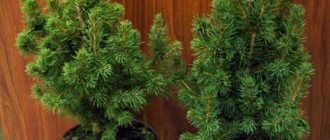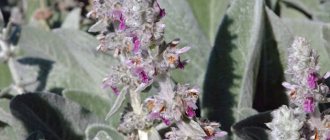Hello everyone!
I haven't been here for a long time, but now I'm back with you! And today we will talk about willow - perhaps the most widespread woody plant in Russia. Willow (Salix)
Well, think for yourself: in general, about 600 species of willows are found in nature. And about 100 of them grow in our country. This is only in the wild!
In different places, willows are called differently. If you come across the following names - willow, willow, willow, lozina, vine, willow - know that this is all willow. By the way, the name “lozina” or “vine” is not unfounded - the branches of almost all types of willows are very flexible and therefore are used in wicker weaving. And sometimes they are even planted specifically for this purpose.
Willow willow, also known as basket willow or twig willow (Salix viminalis) Willows come in different forms: in the form of shrubs or trees, tall and low, with completely different leaves, twigs and bark color.
Willow (Salix integra) 'Hakuro Nishiki'
But more on that later, but now let’s move on to the main thing.
Ads by
Willow planting
Let's start with the soil.
Willow loves sandy soils and loams. If desired, you can fertilize with humus or compost. Although in general, willow is not picky. If possible, choose the area of the site that is the most humid. But we have experience when a weeping willow was planted in front of the house on rather heavy soil, and it did well. Now there’s a whole tree, and it’s so beautiful that people driving by stop and ask for cuttings)). By the way, there are also such ways of planting willow. This is for a hedge. It looks great, tell me? Willow hedge. Photo from rose-club.ru
Or even for a gazebo:
Living gazebo made of willows. Photo from thewillowbank.com
But I think not every willow can be planted this way... Yes, willow is propagated by cuttings. You can also use seeds, but I read that willow seeds are only viable for a week. Maybe it's a lie?
In any case, the tree grows faster from cuttings.
- Cuttings are harvested in the off-season. Ideally - in November or February-March, when sap flow is slow. We choose shoots that are at least 2 years old: there is a greater chance that the branch will take root. Cuttings are cut from the middle of the branch; their length should be about 30 cm.
- Did you cut it? Then we plant it in the ground. For now, at home or in the greenhouse. If you plant several cuttings in one container, the distance between them should be 20-30 cm.
Ideally, willow should be planted in a permanent place in the second year after planting, when the root system has already formed.
They are also planted in the spring, when the snow has melted. To do this, dig a hole of a certain size. For a low-growing willow, a hole measuring 50x50x50 cm will be enough; for a tall willow, make a larger one. We loosen the soil of the hole, fertilize it with humus and moisten it abundantly. And bury the root of the cutting. All. Do not forget to water the willow at first, when it is sick from transplanting. Now let's talk about how to care for willow.
Wicker willow - planting and care
Wicker willow is a wicker tree made from willow twigs.
The main material for plants is Salix viminalis or Willow. On this page you will find rules for caring for wicker willow. Having familiarized yourself with them, you can easily replant such a plant yourself if necessary, and also learn how to form the crown of a plant, thereby arousing genuine interest and admiration of others! You can view prices and find out where plants are sold in the Plant Catalog.
Landing
Planting, or rather transplanting a plant into the ground, is not particularly difficult. For successful establishment of the plant, it is very important to properly prepare the planting site. Willow is quite unpretentious, so in most cases it is enough to dig a hole, the size of which is slightly larger than the plant’s pot. If planting is to be done on heavy, poor or unfavorable soils, then the algorithm is as follows:
- A fairly large hole is dug. For example, for a plant in a 10-liter pot, the perimeter of the hole will be 40 x 40 cm and the depth will be 30-40 cm.
- The excavated soil is removed. In its place, fertile soil is brought in. The bottom is lined with earth or compost.
- Removing the plant from the pot. The plant is sold with a developed root system, so by placing the plant horizontally on the ground, you can quite easily remove a lump of soil with roots from the pot. To simplify the procedure, you may need to lightly tap the pot on all sides.
- Place the dug plant in the hole and, positioning it as needed, sprinkle it evenly with soil on all sides. It is better to alternate filling the soil with simultaneous flooding of the hole with water. In this case, the soil will fill the hole more densely, without leaving any extra spaces with air.
- After planting, be sure to water the plant. The volume of water is at least 10 liters. If the weather is dry (i.e. a complete lack of precipitation), watering should be done daily until the weather changes or the plant shows signs of beginning active growth.
Caring for a plant on the ground.
Caring for a plant planted in the ground in the first year consists of several simple techniques:
- Removing side leaves (shoots) from the trunk of a wicker tree. The video talks about this in some detail.
- Crown formation. It consists of trimming excess crown vegetation. For large volumes of work, it is advisable to acquire gas shears. But pruning can be done with simple garden shears, as well as a simple pruning shears. Forming the crown is also a mandatory step when caring for a plant in a pot!
- In autumn, the plant sheds its leaves and remains dormant (no sap flow) until spring. No additional care is required during this period.
Caring for a plant in a pot.
Like all other plants, grown Wicker Willows will require transplanting into larger pots or containers with soil. This happens for two reasons:
- Large evaporation from the surface of the leaves. When weaving a tree, 36 rods (read trees) are used. A small pot will need to be watered 2 times a day, and a larger pot (for example, 20 liters instead of 5 liters) - once every 2 days.
- The minerals required for growth and maintaining a “fresh” appearance will also need to be added less frequently to a large pot.
- In cases where the plant is located outside (for example, at the entrance to a room), the weight of the pot will give greater stability to the wicker tree.
- In winter, the “Wicker Willow” in a pot should be brought into a room (preferably unheated) to prevent freezing of the plant’s root system.
Willow care
The degree of care depends on the type of willow, planting location and climate. But basically it comes down to two actions:
Watering
If the summer is dry, do not spare water to water the willow tree. We water ours every season, even if it’s not very hot. Sometimes we use buckets, and sometimes we just throw a hose under it for a while. And it feels great! Even in nature, willows grow best along rivers and reservoirs. They are not afraid of small floods in the spring. It’s a pity that the summer photos of our willow were not preserved...
A haircut
This applies only to decorative low-growing willows.
Trimming gives these trees a special flavor. Trimming gives these trees a special flavor. You can choose a willow for your site in our market, which unites large online stores. Section Willow seedlings. Thin columnar willow Mont Aso (C20 H150-175) RUB 12,450
Agrofirm Search
Purple willow Nana (V2-3l.) 408 rub.
Agrofirm Search
Woolly willow (C5/C7.5) 892 rub.
Agrofirm Search
Willow Sverdlovskaya twisting 298 rub.
Agrofirm Search
And if you don’t cut it, then why plant decorative varieties? So don’t be lazy to shape the crown. The branches are thin, there won't be any problems with cutting. But I like regular willows better. They are also very different. That's what we'll talk about next.
Description of creeping willow
Such a shrub or tree looks beautiful. And its compactness allows it to be used very widely in landscape design.
- The shrub high . But sometimes, under favorable conditions, it grows up to 2 m in height. The crown reaches a diameter of 2 m.
- The shrub will grow quite successfully on almost any soil. If the soil at the site chosen for planting is heavy, then you need to lay a drainage layer at the bottom of the planting hole and fill it with a nutrient substrate.
- This plant is a light-loving . It will not grow well in a shaded area. You can plant it in partial shade, but the sun should fall on it for at least half of the daylight hours.
- Since willow tolerates pruning , the crown can be shaped as desired. There are varieties that are a small oval plant that do not need to be pruned.
- Frost resistance is average. Almost all varieties can withstand temperatures down to -25°C. There are also more frost-resistant varieties that are suitable for northern regions.
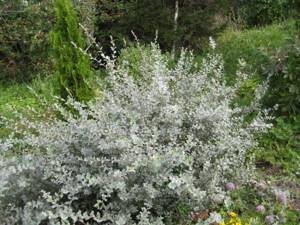
Willow varieties
The most common plant varieties have the following characteristics.
- Common willow reaches an average height of 75 cm. The crown width reaches 120-155 cm. It grows in almost any soil. It loves light, and after transplantation it takes root well.
- Creeping silver willow can grow to only 35-55 cm in height, but the width of the crown can reach 1 m. When the foliage blooms, there is pubescence on the surface, which makes it silvery. The shrub is easy to care for, but it loves good lighting.
- Willow creeping nitida grows up to 58-62 cm and 1 m in width. The plant is dense and can decorate any area. Shoots develop slowly.
- Willow Armando will grow up to 75 cm, crown width up to 1 m. This variety was bred specifically for decorative purposes. In spring, the plant acquires a pinkish color, which makes it very beautiful. When flowering is completed, the branches are pruned to make the crown thicker.
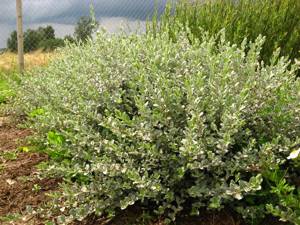
Creeping willow Voothuisen
One of the species, creeping willow Voothuisen, can withstand temperatures down to -29°C. If it is not grown on a trunk, but as a small tree, it can overwinter under a layer of snow. If it is a standard plant, then there is a greater chance that it will be damaged by severe frost.
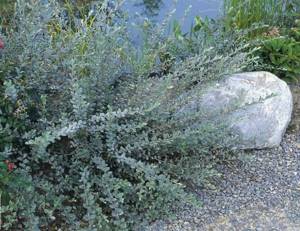
Annual shoots can become severely frozen at low temperatures. If the cold is severe and lasts a long time, the plant may be affected right up to the grafting site. Since this species tends to grow slowly, the willow will take quite a long time to recover.
Therefore, you need to be careful when choosing a landing site. It is best to plant the willow in an area that is protected by some buildings or vegetation. It is very important to provide reliable protection for northern willow.
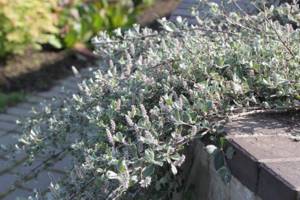
While the crown has not grown, you can wrap it with any covering material. You can plant this willow in a very sunny area or a slightly shaded area. It will grow successfully in any case.
Types of willows
The most common types of willows in the wild are:
White willow (Salix alba)
It is also called willow or willow. The tree reaches a height of 35 meters. The trunk is usually very thick. White willow (Salix alba). Photo: Willow, ru.wikipedia.org
Babylonian willow or weeping willow (Salix babylonica)
This one grows mainly near bodies of water.
Babylonian willow, or weeping willow (Salix babylonica). Photo from the site tvemhaber.com But I’ll say it again, it has taken root well with us. By the way, why crying? Usually this means a special crown shape with sad drooping branches, but it doesn’t always happen like that. Have you ever walked under the willows on a hot, sultry day? It's amazing! You are exhausted from the heat, and then large cold drops fall on you! Babylonian willow is recommended for use when growing in bonsai style. In indoor conditions it grows up to 60 cm. And if you constantly shape it, it will be a nice little tree. Well, if you grow it outside and don’t cut it, it will be weeping.
Goat willow (Salix caprea)
Tree or tree-like bush.
And goat - because goats adore it. The peculiarity is that if you remove the bark, the wood turns red very quickly. In addition, this willow blooms like a willow. Men's earrings are oval, women's are cylindrical. Goat willow (Salix caprea). Photo: Marina Skotnikova, plantarium.ru We have plenty of these in the swamps. I remember every year after school they would break branches and take them home. By the way, this is not easy to do, so we went with scissors)) You can read about your personal experience of growing goat willow in the publication New plant in my garden: goat willow, or Bredina (Salix caprea).
Planting and transplanting
Willows with a closed root system are planted from April to October, and those with an open root system are planted in early spring, before buds open, or in September, with the beginning of leaf fall, then the leaves of the seedlings are removed.
For bush willow seedlings, a hole of 50x50 cm and a depth of 40 cm is needed, for tall willows - 60x60 cm. For large trees, the hole should be 40–50 cm wider than the earthen ball, and 30–40 cm deeper. Fill the hole halfway with a mixture of soil, compost or quail manure and peat in equal proportions, or use ready-made peat soil PETER PEAT “Garden” from the PRO line. Dilute heavy soils with sand (1/5 part) and complex mineral fertilizer (for example, azofoska) - 150–200 g. Mix the mixture in the pit thoroughly. Plant a seedling. Fill with the second half of the soil mixture or prepared soil and mix. Water well.
Growing willow
If you decide to grow creeping willow on your property, you must follow the planting procedure correctly.
- First of all, you need to properly prepare the material for planting. 45-60 days before the planned planting you need to cut the cuttings. Their length should be approximately 30 cm. The material is planted in a pot with a substrate or simply in open ground. If a gardener wants to grow a varietal willow, he needs to purchase a seedling.
- When choosing a planting time, it is better to give preference to the spring or autumn months. When choosing a location, you need to take into account its future size in order to maintain the distance to the fence and other plants on the site.
- Next, a hole with a diameter of about 60 cm and the same depth is dug.
- Drainage should be laid at the bottom, and the length of the layer should be about 18 cm. You can use crushed stone or expanded clay.
- To prepare the substrate, you need to mix 1 part of coarse sand, as well as humus and chernozem - 2 parts of each component.
- The plant is removed from the container carefully so that the earthen lump is not damaged. If the cuttings were planted on the site, they are carefully dug up so that the soil remains on the roots.
- The planting material is installed in the hole and leveled. The hole is filled halfway with the prepared substrate and compacted.
- After this, the hole is filled almost completely and compacted again. You need to leave a depression near the trunk in which water will accumulate when watering.
- The plant is watered with a bucket of water, and when all the liquid is absorbed, another 1 or 2 buckets are poured out.
- Shoots and foliage can be moistened by sprinkling.
- When the water is completely absorbed, a layer of peat is laid as mulch.
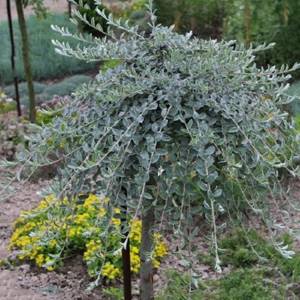
Plant care
Planting and caring for creeping willow, if done correctly, will make the plant beautiful and strong.
- The plant must be watered periodically. In the fall and spring months, water twice a month. In rainy weather this may not be necessary. But there should be a depression near the trunk where water will collect. In summer, watering is needed every week. In extreme heat - twice as often. For one watering, about 2 buckets are used for each bush.
- Fertilizers are applied only at the root. It is advisable to dilute them with water so that they penetrate deeper. Fertilize creeping willow in the first half of summer. If organic fertilizers were applied in the spring months, then a mineral complex can be added in June, and vice versa. And in the autumn, it is better not to fertilize, so that new shoots do not begin to develop.
- From time to time you need to loosen the soil. In the spring, this is done after the snow has melted and the earth has warmed up a little. Loosening depth is 7-9 cm. Humus or peat is suitable as mulch. It is better to loosen the soil after rain, so that the water does not evaporate so intensely. After loosening in the autumn, a layer of grass or peat is placed on the soil around the trunk to insulate the root system.
- Using sterile instruments, crown formation can be carried out. In spring, cut off damaged shoots. Twice a season, in autumn and spring, they are treated with fungicidal agents to prevent the development of fungus. If pests are detected, treatment must be carried out promptly.
- During the first few years, the plant needs to be insulated to protect it from severe frosts in winter. This is especially true for grafted standard plants. Frost can damage the grafts, causing the job to be done again.
- To prevent young shoots from freezing, you should not fertilize in the fall. This causes the shoots to begin to grow before the onset of winter. If the bush is small, it can be covered with agricultural canvas. To protect the bush from the cold wind, you can place a wooden shield from the north.
- When choosing a variety, you need to take into account its frost resistance and the climate in the region.
Each gardener can choose the variety that is most suitable for his site. For example, creeping willow nitida, basket willow or lilac in general will be a good decoration for a composition of plants.

